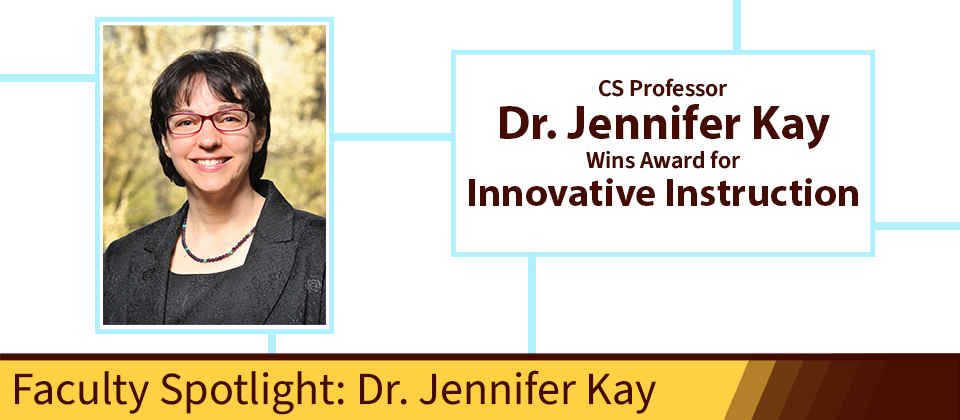Faculty Spotlight: Dr. Jennifer Kay
Faculty Spotlight: Dr. Jennifer Kay
Faculty Spotlight: Dr. Jennifer Kay
Dr. Jennifer Kay is a professor of Computer Science here at Rowan University. She has taught a wide variety of courses in the CS Department, including Computer Science & Programming, Data Structures, Design and Analysis of Algorithms, Robotics, and many more.
Recently, Dr. Kay received an award known as the President’s Award for Excellence in Innovative Instructional Delivery. According to Rowan’s official webpage for the award, this award is given out to faculty who “have gone above and beyond to adapt to an ever-changing classroom environment, or who have provided outstanding contributions to online learning via coursework, programs, or certificates.” Dr. Kay is the most recent recipient of this award for her incredible innovations in online instruction.
In her application for the President’s Award for Excellence in Innovative Instructional Delivery, Dr. Kay explained how she pioneered the usage of Jupyter Notebooks in the CS classroom. The topics that Dr. Kay teaches can sometimes be challenging for students, but Jupyter Notebooks have made it a lot easier for students to grasp some of the more difficult subjects in her graduate Robotics class. This innovation in instruction is what earned her the award.
Now, you may be wondering what exactly a “Jupyter Notebook” even is, so we’ll provide a brief explanation. At first glance, a Jupyter Notebook may appear to be a simple webpage. However, it’s much more than that. Jupyter Notebooks are interactive, allowing students to directly affect elements on the page. For example, say you send a student a page with a 3D graph on it. On a regular document, like a PDF, the graph would just be a static image. However, with a Jupyter Notebook, you could make the graph an interactive element, allowing the student to rotate it and examine it from multiple angles. That isn’t possible with a plain old PDF, but Jupyter Notebooks make it a synch!
Jupyter Notebooks are especially useful because they typically include Python code that can be edited on the fly. For instance, say you want to test your students’ knowledge of one particular concept. A program could involve dozens and dozens of concepts working together at once, but you only want to test them on one concept. To do this, you could include a coding exercise in a Jupyter Notebook with partially complete code. Then, students can fill in the remaining code to show their understanding. This way, the student can tackle the important parts without feeling overwhelmed.
This is especially useful for students trying to wrap their heads around more advanced concepts, like forward kinematics. Forward kinematics is the method used to compute the location of the gripper on a robot arm given some information about the dimensions of the arm and the angles of its joints. According to Dr. Kay, students tend to find this subject difficult to understand, so she’s been taking steps to help students find an easier way to learn. Jupyter Notebooks have been a huge help on that front.
She has already put some plans together to further incorporate Jupyter Notebooks into her lessons in the future. “I want to make the current material thatI have developed for my robotics classes even better. My current vision is that everything turns into one giant Jupyter Notebook. ... I’m going to be working on this over the summer, to take what I’ve learned and make it even better,” Dr. Kay stated in an interview. It’s clear that she is continuing to give it her all when it comes to innovations in education.
Dr. Kay has found this process very rewarding, and loves to see students succeed. She said that one of her favorite parts of teaching is seeing that moment when “something suddenly clicks” and a student who had been confused with the current material now just “gets it,” and you can see that look of understanding in their eyes. It brings Dr. Kay a great amount of satisfaction to help students reach that point, where they fully understand the concepts being taught.
This dedication to her students and innovative thinking in the field of education is what earned Dr. Kay the President’s Award for Excellence in Innovative Instructional Delivery. Our faculty here in the Computer Science Department are always pushing the envelope when it comes to great ways to enhance our students’ education. Be sure to check in soon to hear more about Rowan University’s incredible Computer Science professors.
Written by Cole Goetz | Posted 2022.5.18
